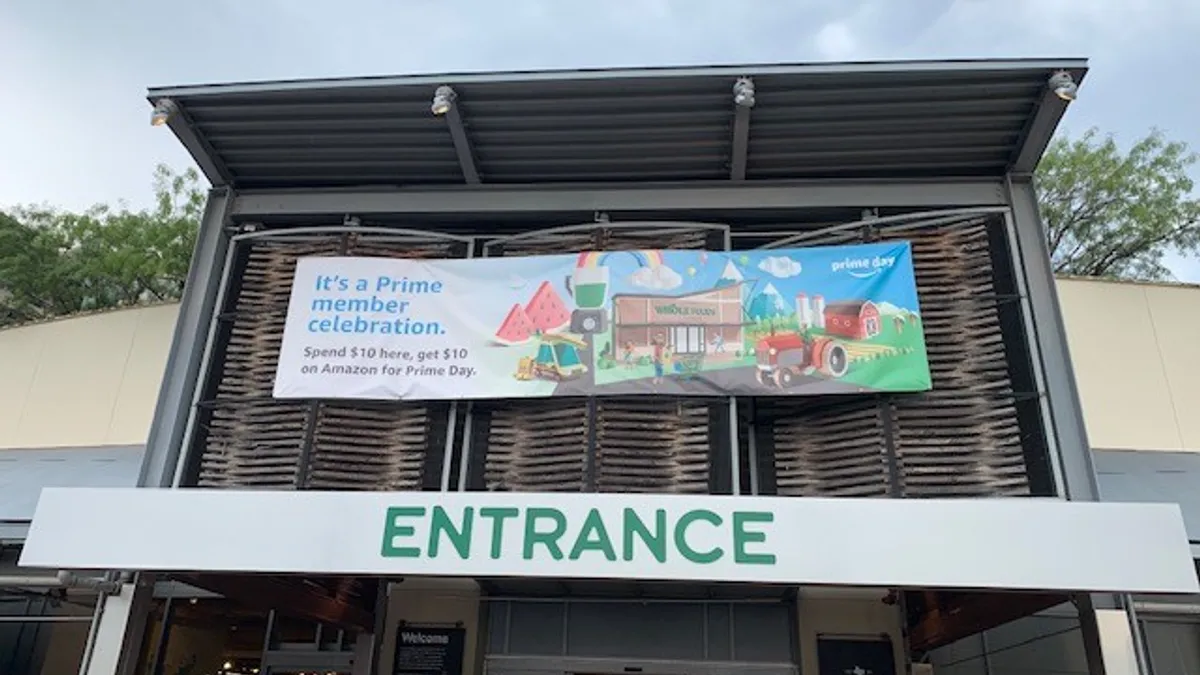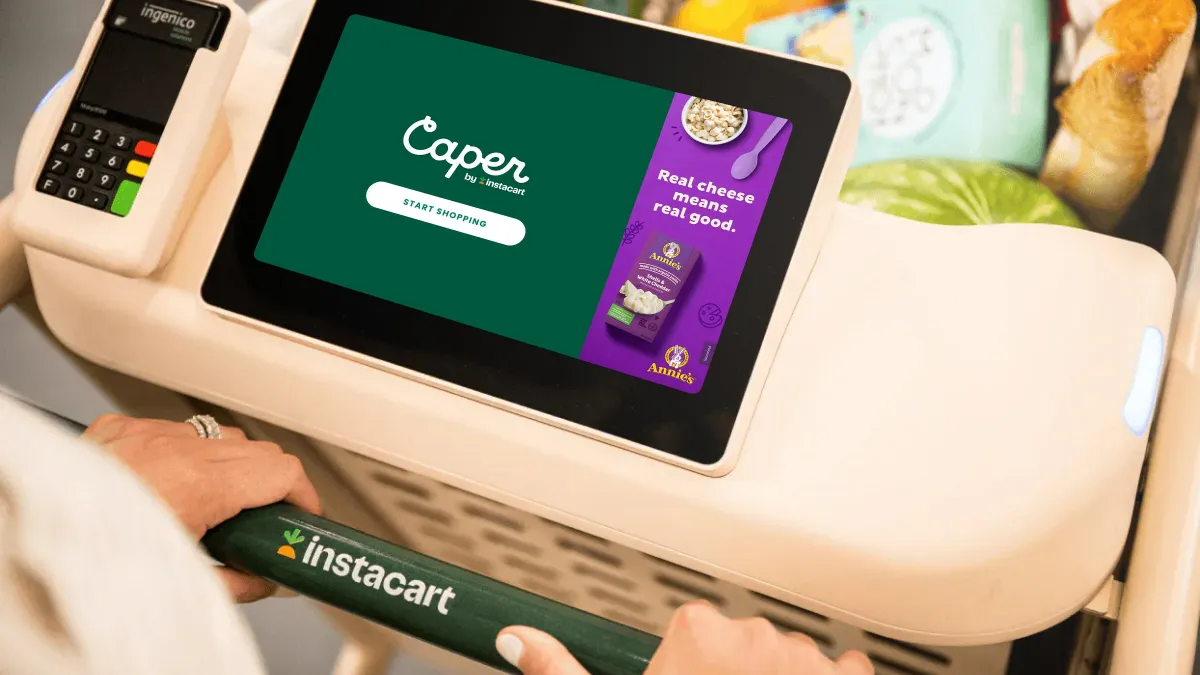The deals were abundant. The discounts were plentiful. And the results? Prime Day 2019 is projected to be a big boost for Amazon, though experts have mixed reviews on whether or not it's the success the company needed in grocery.
At Whole Foods, a week's worth of sales greeted customers in stores and online. Shoppers found discounts on meat, fish, produce, reusable water bottles, muffins and much more — including free reusable grocery bags. Customers who $10 spent at Whole Foods got a $10 credit to use on Amazon, in yet another attempt to tie the specialty chain to the behemoth online retail business.
While Amazon has not released data related to its grocery performance, CEO Jeff Bezos said in a statement that Prime members "received tens of millions of dollars in savings by shopping from Whole Foods Market."
Amazon also tried to breathe some life into its online grocery services. First-time AmazonFresh shoppers could score $15 off their first order, and Prime Pantry customers got $10 off orders of $40 or more.
After the hype and the savings, however, what did Prime Day really mean for Amazon’s grocery business? Grocery Dive spoke to four experts to gather their insights.
Keith Anderson, senior vice president of strategy and insights, Profitero
Analytics platform Profitero tracked early sales data during Prime Day, including grocery products. According to Keith Anderson, senior vice president of strategy and insights, grocery was one of the few categories that performed better on the second day of the event.
"I would say if I had to assign a five-star rating to Prime Day for Amazon's grocery and CPG portfolio, it looks like a 3.5 or 4 out of 5," Anderson told Grocery Dive in an interview.
Fewer big brands were participating than in the past, Anderson said, while select private label grocery products saw big boosts. Private label K-cup coffee on AmazonFresh, for example, went from a ranking of 40,042 to the second-highest ranked item in the grocery and gourmet food category in 24 hours.
Overall, Prime Pantry’s performance was tepid, Anderson said, with Profitero tracking low movement among best-selling products before, during and after the event on the platform. AmazonFresh sales were also underwhelming overall, he noted.
Anderson said the performance demonstrates that Amazon hasn’t made grocery as seamless as it could for shoppers, and that the fragmented offerings across Pantry, Prime Now, AmazonFresh and Whole Foods continue to be a headwind for Amazon’s grocery ambitions.
"It appears to us, based on the data and our observations, that Amazon still has an opportunity to leverage Prime Day to create excitement in grocery and CPG," Anderson said.
Doug Stephens, founder of Retail Prophet
Amazon said it added more new Prime members on July 15 than it ever has on a single day, and almost as many on July 16. These were key details for Retail Prophet Doug Stephens, who told Grocery Dive the important thing to remember is that, especially in grocery, Prime Day is not just about sales.
"I really believe that Prime is a much, much more strategic vehicle for Amazon. I think part of the strategy this year is now moving people over to some of these physical assets like Whole Foods," Stephens said.
Whether or not the deals were good isn’t really the interesting part of the story, either. Stephens said Amazon is using Prime Day to further bring Whole Foods into its ecosystem. The e-tailer also uses the event to create a fear-of-missing-out experience that can garner more attention for the company and its grocery brands.
But in the long-term, Stephens said questions remain.
"Will Amazon be able to move Prime shoppers over to Whole Foods without a very distinct change in positioning for Whole Foods? I think that question remains to be answered," he said.
Justin Belgiano, senior vice president of consumer data practice, Nielsen
According to Nielsen, last year’s 36-hour Prime Day saw a 20% increase in CPG sales, and the research firm predicts an even bigger return this year following a longer promotional period. Nielsen also expects grocery to make big gains this year since it was the second most shopped CPG category last year and accounted for 17% of total U.S. CPG sales on Prime Day.
"We would expect this year to be higher than that and make up a bigger proportion because they are now a year further along in a consumer’s mind of being a place you can get grocery items," Justin Belgiano, senior vice president of Nielsen’s consumer data practice, told Grocery Dive.
Amazon’s extension of Prime Day deals at Whole Foods to a full week made a lot of sense to Belgiano because people’s brick-and-mortar shopping habits are different than their online shopping habits. Two days of brick-and-mortar promotions may not be enough to transform shopper behavior, but a week will catch most customers on their typical shopping day.
"I think that also shows Amazon trying to learn, too, about how people behave in brick-and-mortar versus how they behave online. And it is a fundamentally different set of behaviors," Belgiano said.
Cathy Hotka, founder and CEO of Cathy Hotka & Associates
For retail expert and marketing consultant Cathy Hotka, Prime Day comes down to one thing: Amazon is a master of public relations. Amazon executives, she believes, would probably say that Prime Day was a success if it generated a lot of press.
"They’re good at this … they love the idea of being in the press and being the company that’s talked about," Hotka said.
She also thinks whether or not Amazon was successful in grocery on Prime Day is less important than its continued efforts to innovate in the space.
"The grocery segment can’t be same-old, same-old in this environment," Hotka said. "So there continues to be some amazing innovation in places like Aldi and Lidl and new grocery concepts that are springing up. So I think Amazon needs to be in grocery whether they want to or not."





















